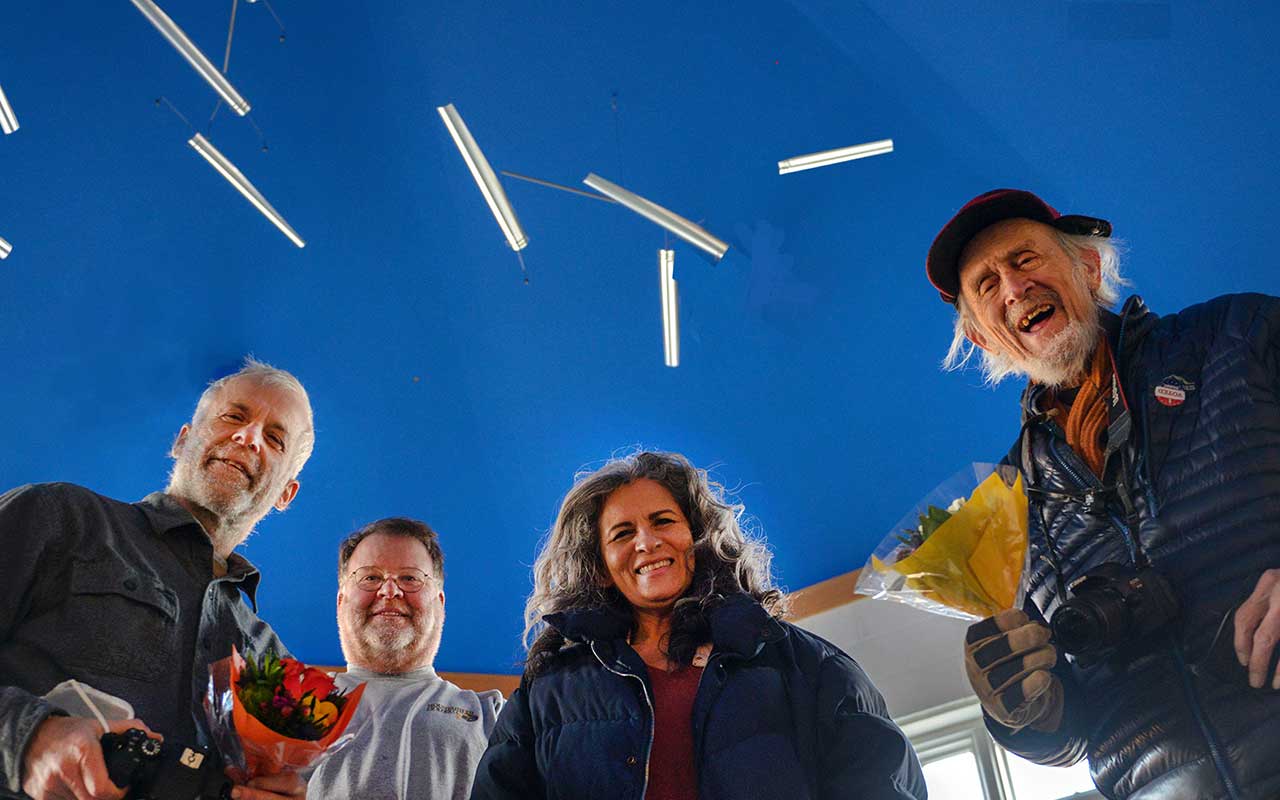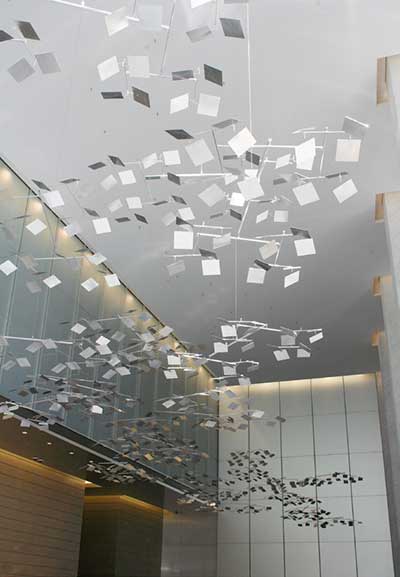Featured Artist

The Big Country Sky
Last winter the Dell Eads Reading Room at Housatonic Valley Regional High School in Falls Village, CT, got some unexpected visitors. Renowned kinetic sculptor, Tim Prentice and his longtime artistic collaborator, Dave Colbert were looking up at the ceiling of the octagonal shaped room, considering the light. Prentice and Colbert were being shown a potential location for an installation they planned to gift to the school in the spring by Pat Vanicky, the school’s art teacher and fellow Cornwall resident. Vanicky had approached Prentice and Colbert with the idea of donating a sculpture to the school in part to inspire students to experiment with sculpture, a practice she teaches as part of the school’s course offerings.
Prentice’s art, which has graced public spaces from New York to Taiwan for close to 50 years now has a permanent home in the Dell Eads Reading Room. The planning of the site-specific installation of the sculpture began with visually assessing the room and then calibrating the sculpture elements to respond to the room’s air flow. The power of kinetic sculpture is its interaction with wind and light. For this piece, Prentice and Colbert worked with wire and highly reflective aluminum tubes to fabricate the sculptural elements. The sculpture is held suspended from the ceiling and is in near constant motion from gusts coming from doors to the outside as well as slight modulations in the HVAC system. Groups of students gathered beneath also create rising air that will cause the sculpture to respond. Anticipating the elements’ response to wind is central to the art and Prentice and Colbert design with this in mind. The artists requested the school paint the ceiling a very particular color – Benjamin Moore 2066-30 Big Country Blue – to create a background for the installation. The selection was to “bring the sky inside, I think,” says Vanicky. The result transformed the room form a functional media center to a place of visual delight.
Making air visible
Prentice was taken by surprise and laughed a little when I asked what his hope was for the piece in its new home. Mulling the question over, he said he hoped the students would “give it a little thought, about how the sculpture makes the air visible.” Prentice recalled his own awakening to kinetic sculpture as a high school student when he visited the Addison Gallery of American Art in Andover, MA, with the wife of a teacher at his boarding school. With no art program at the school at the time, the faculty wife was determined to bring art to the students, or students to the art in this case. It was seeing Alexander Calder’s Horizontal Spines at the Addison that planted the first seed for Tim Prentice. That, and a lifetime considering wind through sailing pursuits and serving on an aircraft carrier in WWII combined to inform his singular brand of art practice and output.
Sculpture that moves and responds to the elements is endlessly fascinating to look at. The reflective nature of the aluminum material, set against a blue background with indirect light on one side of the room means that the work looks different at every minute of every day from every perspective as the weather patterns change outside. This organic quality feels rights at home in a place bustling with teenage activity witnessing the highs and lows of school days. For some, sitting underneath it might provide impetus for energetic idea generation, for others it might offer the opportunity for soothing contemplation or meditation.
Inspiring generations
Prentice and Colbert’s particular brand of kinetic sculpture is unique and by showcasing this art form within the school’s building, Pat Vanicky is not only bringing this art to students, she’s helping to connect students to the rich artistic community in northwest Connecticut. Aspiring artists at Housatonic have unusual access to living “local” artists (many of whom are world renowned) and opportunities to engage with their work. Guest artists are a regular component of the art program here and many graduates go on to top art colleges. The site-specific installation now flittering in the breeze of the library may well provide inspiration to a generation of Housatonic students, and maybe not just those studying art. Vance Cannon, who oversees the Dell Eads Reading room says, “the room is getting a lot of use, especially in the afternoons.”
The room is used by the entire student body and in truth, there’s something in the Prentice/Colbert sculpture for everyone. For students interested in industrial fabrication, the use of simple materials crafted by hand creates an unexpectedly complex effect. For scientists, observing the repeating pattern of the parts making up the whole illustrates a central principle in science. Musicians will see (and hear) the mood of the wind on the sculpture. Geometry students will see angles and shapes in balance. If visitors stare long enough at the sculpture, they are likely to see both precision and whimsy, hard angles and abstraction. Just as a profound imprint was left on Prentice on seeing the work of Alexander Calder at a formative age, the installation of the Prentice/Colbert sculpture may inspire artistic kinship with students who will see it every day for four years. And as is the hope of all artists, maybe it will inspire, challenge or provide respite during that time.
At home with the artist
A visit to the Prentice Cornwall campus with its barns, out buildings and panoramic views gave me insight into the artmaking. Prentice has created his art from his Cornwall studio for close to fifty years and a lot of the idea generation takes place in his barn studio in an old icehouse. Experiments in fabrication abound. Diminutive prototypes cover the wall of the studio, and the property is dotted with full-scale sculptures of one kind or another and many works in progress.
On the day I visited, several large metal sculptures stood askew or in tatters on the landscape after having endured some recent heavy winds. Seeing prototypes on site, shows many of them in their glory, their reflective materials set against rolling Litchfield hills or rough-hewn barnwood. The rustic beauty of the Cornwall landscape elevates Prentice’s art, I think.
 The seemingly complex but simple constructions of interlocking angled wires with metal or plastic planes are incredibly sensitive to moving air. Much of Prentice’s large-scale work is installed in public spaces where the environment or landscape play a role in showcasing the art. Prentice/Colbert sculptures have been installed in public atriums in museums and airports around the world as well as mounted outside in sculpture gardens. Lexan – a composite plastic that comes in various weights and shades of opacity – aluminum and stainless steel are materials of choice for most of the work, though the team has built some sculptures with brightly-colored feathers and has experimented with glass panels as well. All of the kinetic structures appear fragile and delicate but maintain their integrity as they respond to movements in the air. What is constructed from hard industrial and geometric material is made undulating and musical in the wind. One piece, Outdoor Carpet, moves like the magic carpet imagined in children’s books, ready to take flight when the wind picks up speed. Its appearance is flowing, responsive, almost alive, though it is composed of decidedly hard, dead material – small squares of lexan knitted together with wire then suspended from a metal plane. This seeming whimsy or dynamic serendipity is the essence of Prentice’s work.
The seemingly complex but simple constructions of interlocking angled wires with metal or plastic planes are incredibly sensitive to moving air. Much of Prentice’s large-scale work is installed in public spaces where the environment or landscape play a role in showcasing the art. Prentice/Colbert sculptures have been installed in public atriums in museums and airports around the world as well as mounted outside in sculpture gardens. Lexan – a composite plastic that comes in various weights and shades of opacity – aluminum and stainless steel are materials of choice for most of the work, though the team has built some sculptures with brightly-colored feathers and has experimented with glass panels as well. All of the kinetic structures appear fragile and delicate but maintain their integrity as they respond to movements in the air. What is constructed from hard industrial and geometric material is made undulating and musical in the wind. One piece, Outdoor Carpet, moves like the magic carpet imagined in children’s books, ready to take flight when the wind picks up speed. Its appearance is flowing, responsive, almost alive, though it is composed of decidedly hard, dead material – small squares of lexan knitted together with wire then suspended from a metal plane. This seeming whimsy or dynamic serendipity is the essence of Prentice’s work.
His rightful place
In April 2022, Prentice closed a year-long indoor and outdoor exhibition of his work at the Aldrich Museum of Contemporary Art in Ridgefield, CT. The exhibition featured 20 indoor works, five outdoor works, and a video portrait of the artist. The title of the exhibition refers to Alexander Calder, whose mobiles inspired Prentice as a boy and who most in the art world would consider the granddaddy of kinetic art. The work of Tim Prentice and Dave Colbert claims a rightful place in this artistic tradition by creating dynamic work in which forms change in new ways and are constructed of new materials.
Though the show is now closed, Prentice/Colbert sculptures can be seen nearby at the Torrington Court House or Connecticut Science Center in Hartford and at the site of new Sandy Hook Elementary School in Newtown. And now, with great pride of place and through the efforts of an inspired high school art teacher, Housatonic boasts its own original kinetic sculpture from one of Cornwall’s most inventive native sons.
To view the Prentice/Colbert sculpture or the Blue & Gold exhibition currently on view in the Kearcher-Monsell Gallery, please contact main office secretary Cindy Fuller at CFuller@hvrhs.org (860) 824-5123 ext. 1160 to schedule a visit.
Are you an artist and interested in being featured in Main Street Magazine? Send a brief bio, artist’s statement, and a link to your work through the arts form on our “arts” page on our website.

